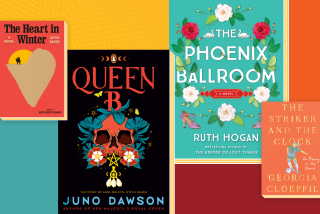Smart heroine casts a spell
Curse of the Thirteenth Fey
The True Tale of Sleeping Beauty
Jane Yolen
Philomel: 256 pp., $16.99; for readers 10 and older
--
We love fairy tales. Every culture offers them up: Scandinavians, Nigerians, Indonesians. Their commonality -- and the constant on-passing from parent to child -- attests to their endurance. Itâs as though they are somehow encoded in our DNA.
Theories abound about their importance in our social evolution: Tales of abandonment, death and monstrous behavior allow children to deal with their fears in an age-appropriate manner. The horror is remote, symbolic; the ritual of reading, sacred.
In the last 50 or so years, fairy tales such as âSleeping Beautyâ have been turned on their ear. The sleeping princess became part of a tourist attraction in a âFractured Fairy Talesâ segment of âRocky and Bullwinkle.â Rather than rhapsodize about her beauty, the prince announces, to no one in particular: âAsleep sheâs a gold mine!â She was imagined as a lust object of sorts in the musical âInto the Woods.â In the second act, Rapunzelâs prince and his brother confess their yearnings for two other beautiful women: Snow White and Sleeping Beauty.
Childrenâs book authors have embraced the revisionist concept with great glee. What better way to build upon tradition while bucking it at the same time?
Jane Yolen, who has written at least 300 books and thousands of poems and short stories and is a Caldecott winner, poked fun of the sleeping princess stereotype in her 1981 childrenâs book âSleeping Ugly.â In 1992âs âBriar Rose,â Yolen let much of her story play out in Nazi Germany. Her latest take is âCurse of the Thirteenth Fey,â subtitled âThe True Tale of Sleeping Beauty.â
âCurseâ opens with the birth of Gorse, the 13th child in a family of Shouting Fey (fairies). The family -- sprawling, dysfunctional and loving -- is tied to the land and wishes of an evil king. When Talia, the kingâs daughter, is born the family is summoned to a christening.
Gorse, both accident- and illness- prone, leaves late for the ceremony, carrying her gift: a spindle with a piece of the âThread of Lifeâ wrapped around it. Parts of the narrative may seem familiar, but anyone who anticipates a happy prince and princess coupling at the end would best be advised to check their old-fashioned notions at the door.
Gorseâs mother is fey; her father, an elf (âand an Irish one at thatâ), a creature without wings who endures teasing and taunts from Gorseâs rather domineering aunts. But Gorseâs father possesses one thing that his in-laws seem to have missed out on: intellect. He immerses himself in a magic library, and Gorse immerses herself as well. The only one of her siblings to take an interest in the life of the mind, Gorse is plowing her way through his volumes, which are arranged alphabetically, when her adventure begins.
As Gorse races, alone, to catch up with her family and the baptism of the royal princess, she falls into a hole at the bottom of a tree, a âmagick trap.â As she makes her way through a mysterious underground world, she encounters a troll, and later his entire family, and a prince of questionable ethics who, along with his cousin, have been trapped underground for countless years. The prince plays mind games with Gorse, using fairy glamour in attempts to trick her. But Gorse is not easily tricked. Through her exchanges with the Prince Orybon, she learns more about the origins of the Shouting Fey and their curse and she struggles mightily to think her way out of her underground prison.
Knowledge gleaned from various books in her fatherâs library is key to her quest. For example, when she fails at her attempt to shout down âThe Gateâ that blocks the way out, Gorse reveals a rudimentary understanding of plate tectonics, of âstone grinding on stone.â And she ponders another kind of big bang, explaining to her companions that a substance covering the walls of her underground prison is bat guano and can be used for the making of explosives.
The 13th fey is one smart cookie, which makes her a very modern heroine, well equipped to handle the perils of the unknown and the challenges of self-rescue. At times, her underground experience feels as though it may never end, but just as a reader might start to experience fairy fatigue, Gorse shares a new morsel of knowledge acquired from her fatherâs library or exhibits astonishing insights into the human condition. Itâs hard to quit her.
Intellect is not Gorseâs only weapon. âAfter all, we were of the line of the Shouting Fey, who can cause death and consternation simply by the timbre of our voices,â she points out. But intellect is what ultimately allows Gorse and her family to reunite and unravel the cruel ties that bind them to the royal family.
Of course, âCurse of the Thirteenth Feyâ is not merely the tale of Gorse; Yolen allows Sleeping Beauty to pop up now and then as a bit player of sorts. Readers do get an inkling of what might be in store for Princess Talia, but as with all fractured fairy tales, itâs not what most of us would imagine.
--
More to Read
Sign up for our Book Club newsletter
Get the latest news, events and more from the Los Angeles Times Book Club, and help us get L.A. reading and talking.
You may occasionally receive promotional content from the Los Angeles Times.







